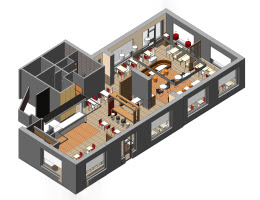OUTSOURCE CREATIVE SERVICES - OUTSOURCE CREATIVE WORKS-OUTSOURCING CREATIVE WORK - OUTSOURCE CREATIVE DESIGN - OUTSOURCE 2D ARTWORKS - 2D ART SERVICES - 2D ART OUTSOURCING - ART OUTSOURCING - OUTSOURCE ILLUSTRATION WORKS - OUTSOURCE ILLUSTRATION SERVICES - OUTSOURCE 3D MODELING - 3D MODEL OUTSOURCING- OUTSOURCING CAD WORKS- OUTSOURCE ARCHITECTURAL SERVICES -BIM - REVIT
The Intersection of CAD & AI in Outsourcing CAD Works
The intersection of Computer-Aided Design (CAD) and Artificial Intelligence (AI) is revolutionizing the outsourcing of CAD works. This powerful combination is enhancing efficiency, accuracy, and innovation in design processes, making it a game-changer for companies seeking to outsource their CAD tasks. Here’s how CAD and AI intersect to transform outsourcing:
1. Enhanced Design Automation
AI-Driven Design Generation: AI algorithms can automatically generate complex design solutions based on initial input parameters. This reduces the need for manual design work, allowing outsourced teams to focus on refining and improving AI-generated concepts.
Generative Design: AI can explore a vast array of design permutations quickly. By defining specific constraints and goals, such as material usage or structural integrity, AI can produce optimized design alternatives that human designers might not consider.
2. Improved Accuracy and Precision
Error Detection: AI can analyze CAD models to detect potential design errors, inconsistencies, or areas that do not meet specified standards. This helps ensure that outsourced work meets high-quality standards, reducing the need for extensive revisions.
Quality Assurance: AI-driven quality control systems can continuously monitor and evaluate the accuracy of CAD designs, ensuring that all outputs adhere to the required specifications and industry standards.
3. Accelerated Prototyping and Iteration
Rapid Prototyping: AI can simulate and test designs in virtual environments, providing immediate feedback on performance and feasibility. This accelerates the prototyping phase, allowing outsourced teams to iterate more quickly and efficiently.
Simulation and Analysis: AI enhances the ability to simulate real-world conditions and stresses on designs. This helps outsourced teams refine models before physical prototypes are created, saving time and resources.
4. Cost and Time Efficiency
Reduced Labor Costs: By automating routine and repetitive tasks, AI reduces the amount of manual labor required. This can lead to significant cost savings, especially when outsourcing to regions with high labor costs.
Faster Turnaround: AI-driven processes can operate 24/7, drastically reducing project timelines. This is particularly beneficial for companies outsourcing CAD works, as it allows for faster completion of projects and quicker time-to-market.
Outsourcing CAD Services
5. Customization and Personalization
Adaptive Design: AI can tailor CAD designs to meet specific client needs and preferences. This enables outsourced teams to deliver highly customized solutions without significantly increasing time or costs.
Mass Customization: AI facilitates the creation of personalized designs on a mass scale. Outsourced teams can leverage AI to produce individualized products efficiently, catering to the growing demand for customization.
6. Enhanced Collaboration
Cloud-Based AI Tools: AI integrated with cloud-based CAD platforms allows for real-time collaboration between in-house teams and outsourced providers. This seamless communication ensures that everyone is on the same page, reducing misunderstandings and enhancing productivity.
Language and Communication: AI-driven natural language processing (NLP) tools can bridge communication gaps, translating technical jargon and ensuring clear, precise communication between geographically dispersed teams.
7. Data-Driven Insights
Predictive Analytics: AI can analyze historical data to predict future design trends and outcomes. This helps outsourced teams make informed decisions and create designs that are more likely to succeed in the market.
Optimization: AI can continuously learn from past projects to optimize future designs. This iterative learning process helps improve the quality and efficiency of outsourced CAD work over time.
8. Security and Compliance
Data Security: AI enhances data security by monitoring and managing access to sensitive CAD files. This is crucial when outsourcing to ensure that proprietary information is protected.
Regulatory Compliance: AI can ensure that CAD designs comply with industry regulations and standards. This reduces the risk of non-compliance and associated penalties for outsourced work.
9. Scalability
Scalable Solutions: AI enables scalable design solutions, allowing outsourced providers to handle projects of varying sizes and complexities efficiently. This flexibility is particularly advantageous for companies with fluctuating design needs.
Resource Allocation: AI can optimize resource allocation, ensuring that the right amount of computational power and human expertise is applied to each project. This enhances efficiency and reduces waste.
Conclusion
The integration of CAD and AI in outsourcing CAD works offers numerous benefits, including enhanced design automation, improved accuracy, accelerated prototyping, and cost efficiency. By leveraging AI’s capabilities, companies can achieve higher quality, more innovative designs while reducing costs and time-to-market. As AI technology continues to evolve, its impact on outsourcing CAD works will only grow, driving further advancements and efficiencies in the field.
.jpg)
.jpg)
.jpg)
.jpg)
.jpg)


.jpg)
